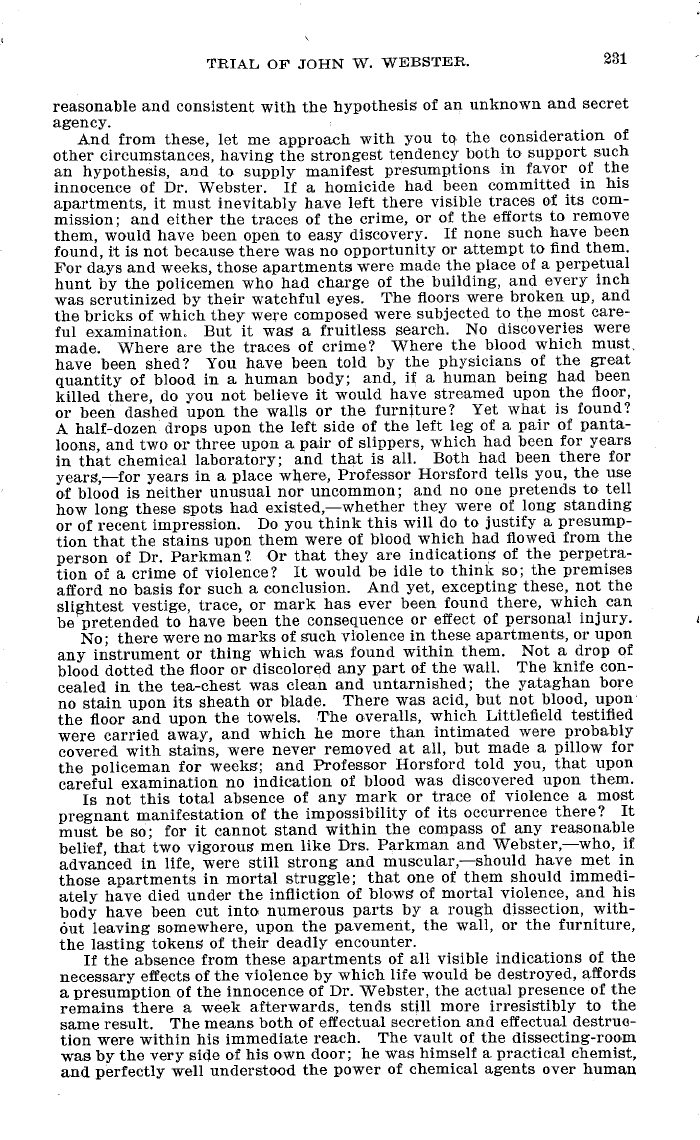|
TRIAL OF JOHN W. WEBSTER. 231
reasonable and consistent with the hypothesis of an unknown and secret
agency.
And from these, let me approach with you to the consideration of
other circumstances, having the strongest tendency both to support such
an hypothesis, and to supply manifest presumptions in favor of the
innocence of Dr. Webster. If a homicide had been committed in his
apartments, it must inevitably have left there visible traces of its com-
mission; and either the traces of the crime, or of the efforts to remove
them, would have been open to easy discovery. If none such have been
found, it is not because there was no opportunity or attempt to find them.
For days and weeks, those apartments were made the place of a perpetual
hunt by the policemen who had charge of the building, and every inch
was scrutinized by their watchful eyes. The floors were broken up, and
the bricks of which they were composed were subjected to the most care-
ful examination. But it was a fruitless search. No discoveries were
made. Where are the traces of crime? Where the blood which must,
have been shed? You have been told by the physicians of the great
quantity of blood in a human body; and, if a human being had been
killed there, do you not believe it would have streamed upon the floor,
or been dashed upon the walls or the furniture? Yet what is found?
A half-dozen drops upon the left side of the left leg of a pair of panta-
loons, and two or three upon a pair of slippers, which had been for years
in that chemical laboratory; and that is all. Both had been there for
years,-for years in a place where, Professor Horsford tells you, the use
of blood is neither unusual nor uncommon; and no one pretends to tell
how long these spots had existed,-whether they were of long standing
or of recent impression. Do you think this will do to justify a presump-
tion that the stains upon them were of blood which had flowed from the
person of Dr. Parkman? Or that they are indications of the perpetra-
tion of a crime of violence? It would be idle to think so; the premises
afford no basis for such a conclusion. And yet, excepting these, not the
slightest vestige, trace or mark has ever been found there, which can
be pretended to have been the consequence or effect of personal injury.
No; there were no marks of such violence in these apartments, or upon
any instrument or thing which was found within them. Not a drop of
blood dotted the floor or discolored any part of the wall. The knife con-
cealed in the tea-chest was clean and untarnished; the yataghan bore
no stain upon its sheath or blade. There was acid but not blood, upon
the floor and upon the towels. The overalls, which Littlefield testified
were carried away, and which he more than intimated were probably
covered with stains, were never removed at all, but made a pillow for
the policeman for weeks; and Professor Horsford told you, that upon
careful examination no indication of blood was discovered upon them.
Is not this total absence of any mark or trace of violence a most
pregnant manifestation of the impossibility of its occurrence there? It
must be so; for it cannot stand within the compass of any reasonable
belief, that two vigorous men like Drs. Parkman and Webster,-who, if
advanced in life, were still strong and muscular,-should have met in
those apartments in mortal struggle; that one of them should immedi-
ately have died under the infliction of blows of mortal violence, and his
body have been cut into numerous parts by a rough dissection, with-
out leaving somewhere, upon the pavement, the wall, or the furniture,
the lasting tokens of their deadly encounter.
If the absence from these apartments of all visible indications of the
necessary effects of the violence by which life would be destroyed, affords
a presumption of the innocence of Dr. Webster, the actual presence of the
remains there a week afterwards, tends still more irresistibly to the
same result. The means both of effectual secretion and effectual destruc-
tion were within his immediate reach. The vault of the dissecting-room
was by the very side of his own door; he was himself a, practical chemist,
and perfectly well understood the power of chemical agents over human
|

